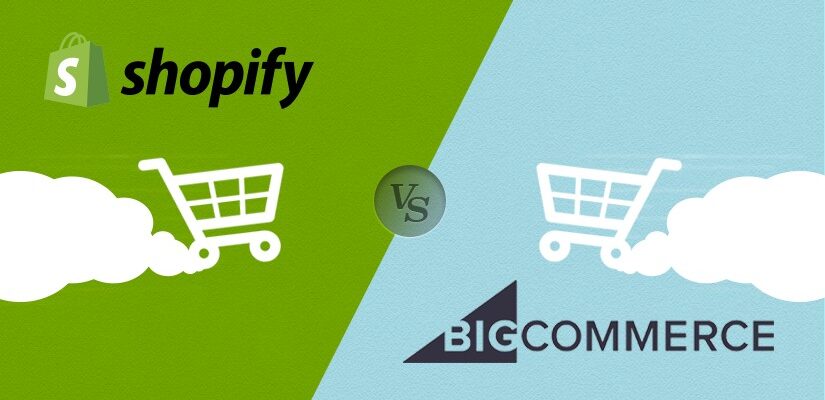- Which is better for an online store: Shopify vs BigCommerce
- Admin panel
- Design and templates
- Helpdesk
- Extensions and plugins
- Integration of payment systems
- Speed
- Which platform is better for promotion, Shopify or BigCommerce?
- SEO promotion
- Integration with marketplaces
- Analytics and reporting
- Shopify vs. BigCommerce cost comparison
- BigCommerce Fees
- Shopify Rates
- Which should I choose BigCommerce or Shopify?
- Pros and cons of BigCommerce
- Advantages and disadvantages of Shopify
With online shopping now more popular than ever, choosing the right platform for building and managing an online store is one of the key criteria for a successful business.
Next, let’s take a detailed comparison of the two giants in the ecommerce industry to find out which is better – Shopify or BigCommerce. Let’s take a look at their features, pricing, and ease of use to help you make an informed decision.
Which is better for an online store: Shopify vs BigCommerce
To find out which is better for eCommerce, BigCommerce or Shopify, let’s go through the main criteria that you need to take into account when choosing an engine for an online store. This will help to understand for which types of businesses and entrepreneurs each of the platforms may be the most suitable solution.
How many calls and sales will I get by ordering contextual advertising from you?
I need to calculate the conversion of my website Describe
the task
in the application
Calculate potential ad revenue Google
contextual advertising calculator
Admin panel
Shopify’s admin panel has a simple and intuitive interface, where you can easily access the main functions – adding products, managing orders, setting up discounts and information about customers.
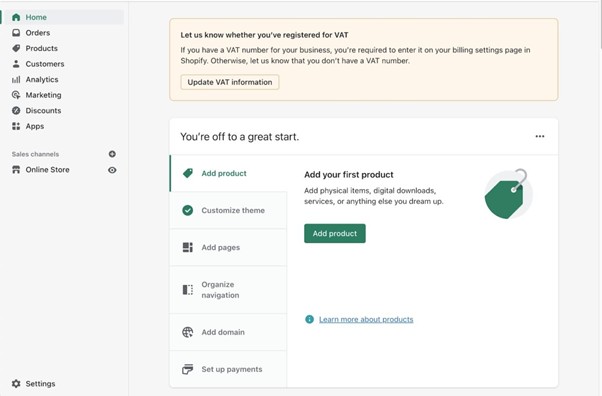
On the left side of the panel is a vertical menu with main sections, which makes it easier to navigate the platform. At the top, you’ll find useful alerts for new orders, customers, or messages.
BigCommerce also has a fairly powerful and flexible admin panel with a focus on convenience and efficiency. The interface is designed to provide users with quick access to key functionality.

The vertical menu is located on the left, as in Shopify, provides access to products, orders, customers, marketing and analytics. However, the menu structure is deeper and contains more settings.
Design and templates
Shopify offers around 70 templates, including 10 free ones. They are developed by professionals and adapted for various business sectors.

All themes are responsive, optimized for different devices and screen sizes. A handy visual editor is also available, allowing users to easily customize the look and feel without programming skills.
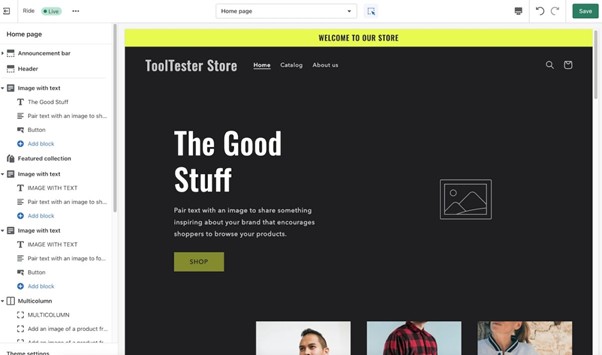
But for BigCommerce, over 150 different templates have been developed, among which about 12 are distributed free of charge. All of them are responsive and suitable for any device and screen size.

Editing a theme is less intuitive here. At the same time, for experienced users who know HTML, Java Script and CSS, there are much more opportunities for customization here.
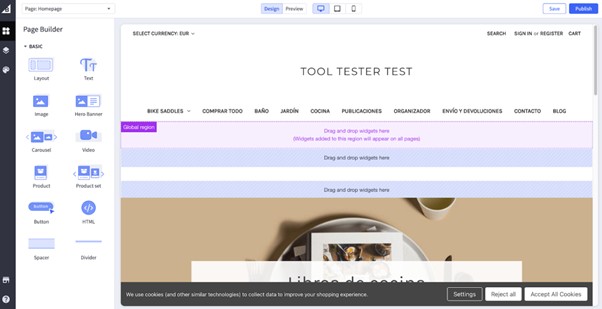
Helpdesk
Shopify has some of the best customer support in the industry, available 24/7 via phone, email and live chat. You can also ask a question in the official communities on Twitter and Facebook.
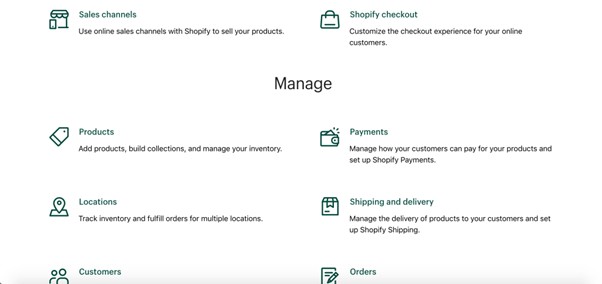
In addition, there is an extensive knowledge base containing articles, guides and video tutorials on various aspects of using the platform, and a special forum where you can ask questions to other sellers and experts.
BigCommerce is not too far behind in this regard, which also provides users with advice 24/7. For complex issues, you can not only contact the phone number or write an e-mail, but also use the active user community forum or groups on social networks.
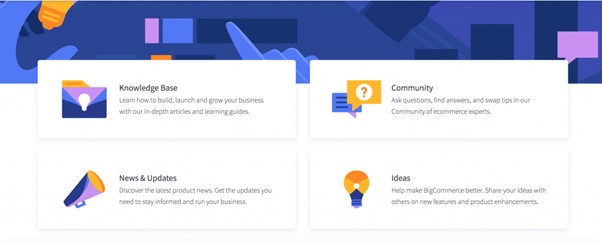
Extensions and plugins
Shopify App Store is one of the most comprehensive marketplaces with extensions. There you can download more than 7000 applications and plugins. The range includes free and paid modules for warehouse management, marketing, analytics, feedback management, etc. At the same time, you can expand the functionality of your store even without specialized experience due to an intuitive interface and simple installation.
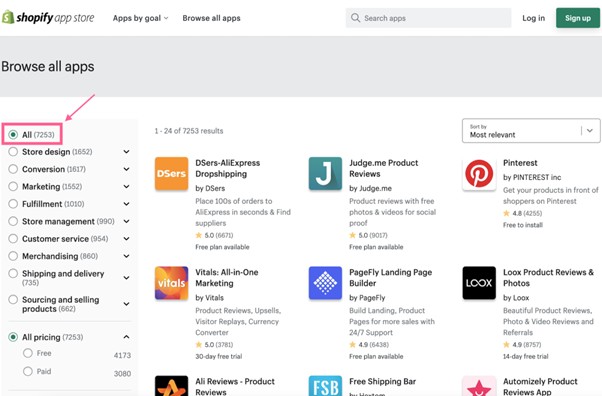
You can download about 1000 extensions from the BigCommerce App Marketplace, but they cover all the basic areas a merchant needs. Installation and configuration is not difficult even for a beginner. True, most of the applications are paid.
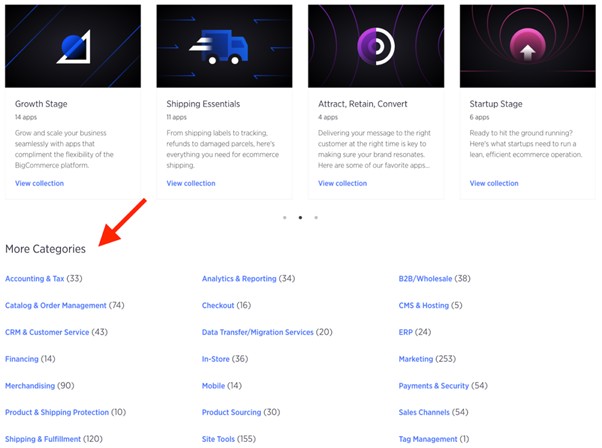
Integration of payment systems
Shopify Payments is the system’s own payment gateway, developed in collaboration with Stripe. With it, you can accept credit cards, PayPal, Apple Pay and Google Pay without the need to connect third-party services.
How many calls and sales will I get by ordering contextual advertising from you?
I need to calculate the conversion of my website Describe
the task
in the application
Calculate potential ad revenue Google
contextual advertising calculator
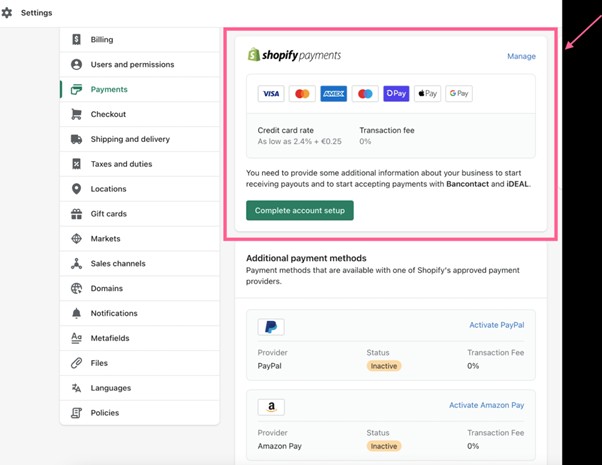
In addition, Shopify supports over 100 third-party payment gateways (Authorize.Net, 2Checkout, Worldpay and many more). However, when using an external provider, an additional fee is charged for each transaction.
BigCommerce doesn’t have its own provider, but it supports over 65 other services. Among them are Stripe, PayPal, Authorize.Net, 2Checkout, Worldpay and others. An important advantage is the absence of additional fees for using third-party payment systems.
Speed
Shopify is known for its high performance and load speed optimizations. Thanks to the global infrastructure and the use of CDN (Content Delivery Network), fast display of content from anywhere in the world is guaranteed.
The platform also auto-optimizes images and offers tools to compress and optimize source code to help speed up loading times.
BigCommerce also uses cutting-edge technology and architecture to provide a reliable and fast experience. It also uses a CDN to speed up the site from different countries, and all images are compressed when added in the admin panel.
Which platform is better for promotion, Shopify or BigCommerce?
The choice of an engine for an online store plays a significant role not only in ease of management and customization, but also in the successful promotion of a business. Let’s figure out which CMS is better – BigCommerce or Shopify in terms of marketing and analytics.
SEO promotion
Successful SEO (Search Engine Optimization) of the store allows it to occupy high positions in search engines and attract the target audience from there. To do this, the functionality of the CMS should allow the administrator to optimize the content, site structure, implement micro-markup, etc.
Shopify makes it easy to edit meta tags, titles, descriptions, and page URLs. Also, the sitemap.xml file is automatically generated here, which simplifies the indexing of the resource by search engines.
In addition, there are many SEO applications available in the App Store for additional optimization. However, it is worth noting that the URL structure of product pages and filters contains additional parameters, which leads to duplicate content.
BigCommerce has all the advantages listed above. At the same time, it allows you to use CNC (human-readable URLs) for product pages and listings, which is an additional plus for ranking and indexing.
Integration with marketplaces
Shopify supports all popular marketplaces including Amazon, eBay, Walmart, Etsy and more. For this, specialized plugins from the App Store are used.
This allows you to automate the process of loading goods, control stock balances and process orders through a single administrative panel Shopify. However, most of these extensions are paid.
The BigCommerce App Marketplace also allows you to download plugins for integration with major marketplaces. At the same time, some of them can also be distributed on a paid basis and have certain functional limitations.
Analytics and reporting
Monitoring and analyzing the behavior of customers on the site will help determine the direction for the growth of the project. Shopify has built-in analytics to track sales, visits, traffic sources, conversions and other key metrics.
Depending on the chosen tariff plan, different levels of reporting are available. In addition, support for Google Analytics has been implemented to obtain additional data on the behavior of visitors.
BigCommerce’s internal analytics system also generates detailed reports on products, orders, customers, marketing, and more. It also supports integration with Google Analytics, and applications for advanced reporting are available in the App Marketplace.
Shopify vs. BigCommerce cost comparison
It is important to consider not only the cost of the platform itself, but also the additional costs of applications and plugins that may affect the overall budget of your project. Let’s do a comparison between BigCommerce and Shopify, which will take into account the main pricing plans, included services and possible additional costs.
BigCommerce Fees
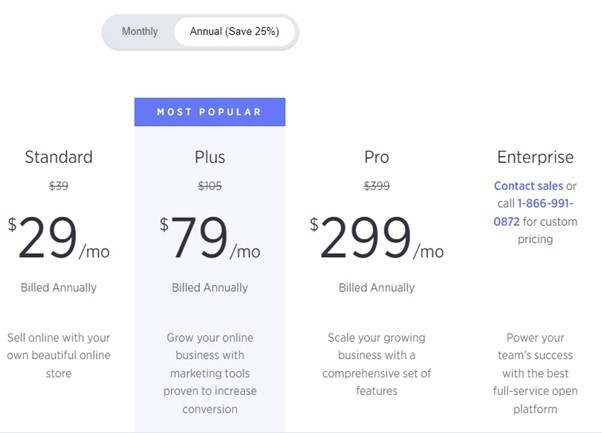
- Standard. Suitable for small shops. As part of this plan, you can add an unlimited number of products, downloads, order history, built-in analytics, access for one manager and the ability to integrate with payment systems without additional fees.
- Plus. Designed for growing businesses. Its functionality is somewhat wider. It includes customer segmentation and connection of discount offers. Multi-user access is also possible, allowing you to add up to 5 administrator accounts. An API is also available on this tariff for integration with external systems and automation of business processes.
- Pro. Includes all Plus features plus integration with Google Customer Reviews and popular shipping services. At the same time, the subscription fee may increase if the monthly traffic limit is exceeded.
- Enterprise. Designed for large and fast growing businesses with individual needs. In addition to all the standard features, it allows you to create personalized price lists, includes priority support, a dedicated manager, improved performance and security, as well as interaction with corporate systems. The price is calculated on an individual basis and depends on the required functionality.
Each of the tariffs has a free trial period of 15 days, which allows you to try out the platform and determine the appropriate set of functions. In addition, it is worth considering possible additional costs for plugins, theme purchases, etc.
Shopify Rates
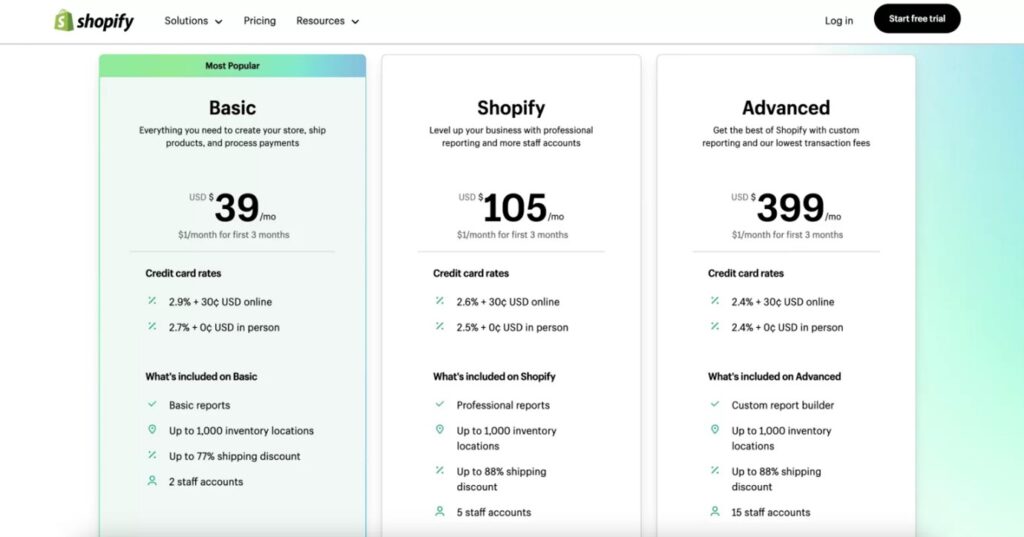
- Basic. Suitable for small projects. Here you can upload an unlimited number of product items, create accounts for two employees, get 24/7 support from specialists, built-in integration with payment systems and analytics, and create discounts and gift cards.
- Shopify. Will be of interest to growing businesses. All Basic features are included here, in addition, it is allowed to create an account for 5 employees, professional reports and adjust shipping rates. Also in this regard, a lower commission for working with external payment systems.
- Advanced. Here, the transaction fee is even lower. Up to 15 employees can work with the system at the same time. It also provides advanced reporting and real-time shipping rates.
- Plus. Specially designed for large enterprises and corporate clients with individual requirements. Provides high scalability, improved security, a personal manager and additional integrations. The cost is calculated individually, taking into account the needs and size of the business.
It is important to note that the platform offers a 14-day trial period, during which you can test all the necessary tools and decide if this CMS is right for you.
Which should I choose BigCommerce or Shopify?
In order to decide whether to choose Shopify or BigCommerce, it is important to know the strengths and weaknesses of each of these CMS.
Pros and cons of BigCommerce
Among the key advantages are the following:
- No transaction fees. Unlike Shopify, there are no commissions for using third-party gateways, which will help you save a lot.
- Many built-in functions. This reduces dependence on third-party applications and modules, as well as reduces the cost of purchasing them.
- Flexible tax and shipping configuration. This makes it easy to adapt the store to the laws and working conditions in different countries and regions.
- Scalability. As your online business develops, you can simply upgrade to a higher tariff without having to change the platform itself.
You also need to remember about the cons:
- Admin panel complexity. It will be a little more difficult to figure it out compared to Shopify, but for an experienced seller it will not be difficult.
- Restrictions. Some plans have a cap on annual sales, which may result in you paying more when you reach a certain income level.
- Fewer free templates. Also, their quality is somewhat worse compared to Shopify, so you may have to consider a paid solution.
- Less developer community. The platform is less popular, which may affect the availability of third-party developments and specialists for store customization.
Advantages and disadvantages of Shopify
The benefits of this engine include:
- Ease of use. An intuitive interface is easy to learn even for a beginner, so a programmer is not required to create and configure an online store.
- Huge selection of templates. You can choose from a large number of high-quality free and premium themes to create a unique and attractive design for your store.
- A huge ecosystem of applications. Allows you to significantly expand the functionality of the site and integrate with various services.
- 24/7 support. Shopify provides 24/7 customer support via phone, email, and live chat to ensure issues are resolved quickly.
There are some shortcomings:
- Transaction fees. If you use external payment systems, this may negatively affect your profits, because the platform requires an additional payment for them.
- Limited built-in functionality. Unlike BigCommerce, there is more reliance on third-party extensions, which can increase the overall cost and complexity of project management.
- Liquid. This is the proprietary templating language used by Shopify. For programmers unfamiliar with it, it can cause certain difficulties. It will also make it difficult to find a specialist to work with the resource.
- Localization and multicurrency. You may need to use third-party plugins to support multiple languages and foreign currencies.

